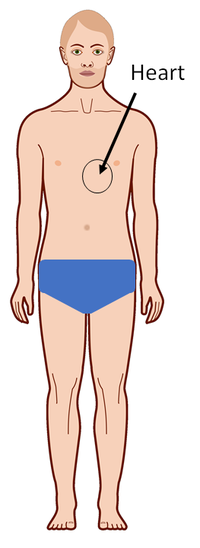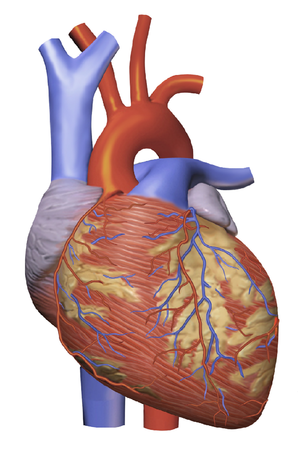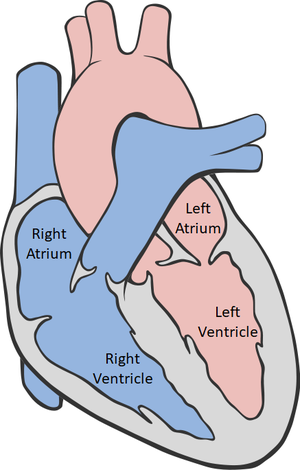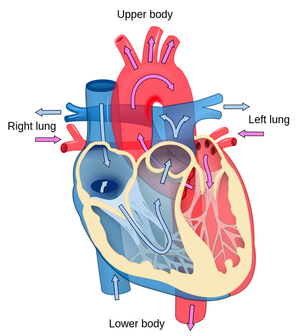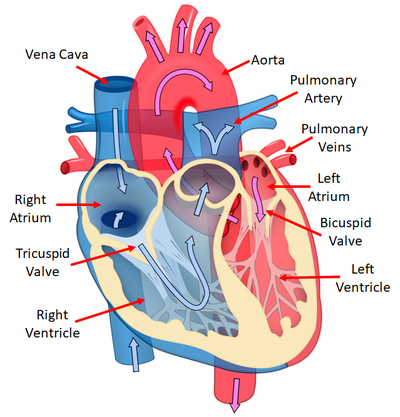Difference between revisions of "Heart"
(→Key Stage 3) |
|||
| (20 intermediate revisions by 2 users not shown) | |||
| Line 1: | Line 1: | ||
==Key Stage 1== | ==Key Stage 1== | ||
===Meaning=== | ===Meaning=== | ||
| − | The '''heart''' is a part of the body in the centre of your | + | The '''heart''' is a part of the body in the centre of your chest. |
{| class="wikitable" | {| class="wikitable" | ||
|- | |- | ||
| Line 11: | Line 11: | ||
==Key Stage 2== | ==Key Stage 2== | ||
===Meaning=== | ===Meaning=== | ||
| − | The '''heart''' is an [[organ]] which | + | The '''heart''' is an [[organ]] which pumps [[blood]] around the body. |
{| class="wikitable" | {| class="wikitable" | ||
|- | |- | ||
| Line 19: | Line 19: | ||
|} | |} | ||
| − | ==About the Heart== | + | ===About the Heart=== |
: The '''heart''' is mostly [[muscle]]. | : The '''heart''' is mostly [[muscle]]. | ||
: The [[muscle]]s in the '''heart''' squeeze and relax to pump [[blood]]. | : The [[muscle]]s in the '''heart''' squeeze and relax to pump [[blood]]. | ||
| Line 28: | Line 28: | ||
==Key Stage 3== | ==Key Stage 3== | ||
===Meaning=== | ===Meaning=== | ||
| − | + | [[File:HeartPicture.png|right|300px|thumb|A computer generated image of a [[heart]].]] | |
| − | + | The [[heart]] is an [[organ]] which pumps [[blood]] around the body. | |
| − | |||
| − | |||
| − | | | ||
| − | |||
| − | |||
===About the Heart=== | ===About the Heart=== | ||
| − | : The [[heart]] is made of [[Muscle Tissue|muscle tissue]], [[ | + | : The [[heart]] is made of [[Muscle Tissue|muscle tissue]], [[Connective Tissue|connective tissue]], [[Nerve Tissue|nerve tissue]], and [[blood]]. |
: The [[muscle]]s in the [[heart]] [[contract]] and relax to pump [[blood]]. | : The [[muscle]]s in the [[heart]] [[contract]] and relax to pump [[blood]]. | ||
: A healthy [[heart]] beats around 70 times per minute when you are resting. | : A healthy [[heart]] beats around 70 times per minute when you are resting. | ||
| Line 42: | Line 37: | ||
: The [[heart]] is protected by the [[Rib Cage|rib cage]]. | : The [[heart]] is protected by the [[Rib Cage|rib cage]]. | ||
: The [[heart]] has 4 separate chambers; the [[Right Atrium]], [[Right Ventricle]], [[Left Atrium]] and [[Left Ventricle]]. | : The [[heart]] has 4 separate chambers; the [[Right Atrium]], [[Right Ventricle]], [[Left Atrium]] and [[Left Ventricle]]. | ||
| + | |||
{| class="wikitable" | {| class="wikitable" | ||
|- | |- | ||
|[[File:HeartChambers.png|center|300px]] | |[[File:HeartChambers.png|center|300px]] | ||
| + | |[[File:HeartBloodFlow.png|center|300px]] | ||
|- | |- | ||
| style="height:20px; width:300px; text-align:center;" |A [[diagram]] showing the 4 chambers of the [[heart]]. | | style="height:20px; width:300px; text-align:center;" |A [[diagram]] showing the 4 chambers of the [[heart]]. | ||
| + | | style="height:20px; width:300px; text-align:center;" |A [[diagram]] showing the [[blood]] flow through the [[heart]]. | ||
|} | |} | ||
| − | : [[Deoxygenated]] [[blood]] enters the [[Right Atrium|right atrium]]. The [[atria]] contract, pushing the [[blood]] from the [[Right Atrium|right atrium]] into the [[Right Ventricle|right ventricle]]. The [[ventricle]]s contract pushing the [[blood]] out of the [[Right Ventricle|right ventricle]] towards the [[lung]]s. [[Oxygenated]] [[blood]] returns from the [[lung]]s and enters the [[Left Atrium|left atrium]]. The [[atria]] contract, pushing the [[blood]] from the [[Left Atrium|Left atrium]] into the [[Left Ventricle|Left ventricle]]. The [[ventricle]]s contract pushing the [[blood]] out of the [[Left Ventricle|Left ventricle]] to the rest of the | + | : [[Deoxygenated]] [[blood]] enters the [[Right Atrium|right atrium]]. The [[atria]] contract, pushing the [[blood]] from the [[Right Atrium|right atrium]] into the [[Right Ventricle|right ventricle]]. The [[ventricle]]s contract pushing the [[blood]] out of the [[Right Ventricle|right ventricle]] towards the [[lung]]s. [[Oxygenated]] [[blood]] returns from the [[lung]]s and enters the [[Left Atrium|left atrium]]. The [[atria]] contract, pushing the [[blood]] from the [[Left Atrium|Left atrium]] into the [[Left Ventricle|Left ventricle]]. The [[ventricle]]s contract pushing the [[blood]] out of the [[Left Ventricle|Left ventricle]] to the rest of the body. |
{| class="wikitable" | {| class="wikitable" | ||
| + | |[[File:CG_Heart.gif|center]] | ||
|- | |- | ||
| − | |[[ | + | | style="height:20px; width:600px; text-align:center;" |A computer generated animation of the [[heart]] pumping. |
| − | |[[File: | + | |} |
| + | |||
| + | ==Key Stage 4== | ||
| + | ===Meaning=== | ||
| + | The [[heart]] is an [[organ]] in the [[Circulatory System|circulatory system]] which pumps [[blood]] around the body. | ||
| + | |||
| + | ===About the Heart=== | ||
| + | : The [[heart]] has 4 separate chambers; the [[Right Atrium]], [[Right Ventricle]], [[Left Atrium]] and [[Left Ventricle]]. | ||
| + | : [[Deoxygenated]] [[blood]] enters the [[Right Atrium|right atrium]] from the [[Vena Cava]]. The [[atria]] contract, pushing the [[blood]] from the [[Right Atrium|right atrium]] through the [[Tricuspid Valve|tricuspid valve]] into the [[Right Ventricle|right ventricle]]. The [[ventricle]]s contract pushing the [[blood]] out of the [[Right Ventricle|right ventricle]] through the [[Semilunar Valve|semilunar valve]] into the [[Pulmonary Artery|pulmonary artery]] which takes [[blood]] to the [[lung]]s. [[Oxygenated]] [[blood]] returns from the [[lung]]s through the [[Pulmonary Vein|pulmonary veins]] and enters the [[Left Atrium|left atrium]]. The [[atria]] contract, pushing the [[blood]] from the [[Left Atrium|Left atrium]] through the [[Bicuspid Valve|bicuspid valve]] into the [[Left Ventricle|Left ventricle]]. The [[ventricle]]s contract pushing the [[blood]] out of the [[Left Ventricle|Left ventricle]] through the [[Semilunar Valve|semilunar valve]] into the [[Aorta]] which takes the [[blood]] to the rest of the body. | ||
| + | {| class="wikitable" | ||
| + | |- | ||
| + | |[[File:HeartDiagramKS4.png|center|400px]] | ||
|- | |- | ||
| − | | style="height:20px; width:300px; text-align:center;" |A [[diagram]] showing the | + | | style="height:20px; width:300px; text-align:center;" |A [[diagram]] showing the features of the [[heart]]. |
|} | |} | ||
| + | |||
| + | ===References=== | ||
| + | ====Edexcel==== | ||
| + | |||
| + | :[https://www.amazon.co.uk/gp/product/1782945741/ref=as_li_tl?ie=UTF8&camp=1634&creative=6738&creativeASIN=1782945741&linkCode=as2&tag=nrjc-21&linkId=30da4f2178da182547b62a7329d13b57 ''Heart (structure of), page 63, GCSE Combined Science; The Revision Guide, CGP, Edexcel ''] | ||
| + | :[https://www.amazon.co.uk/gp/product/1782946748/ref=as_li_tl?ie=UTF8&camp=1634&creative=6738&creativeASIN=1782946748&linkCode=as2&tag=nrjc-21&linkId=a4f0348fc37d0ba1bb52d27f8679581f ''Heart (structure of), page 91, GCSE Biology; The Revision Guide, CGP, Edexcel ''] | ||
| + | :[https://www.amazon.co.uk/gp/product/1782948120/ref=as_li_tl?ie=UTF8&camp=1634&creative=6738&creativeASIN=1782948120&linkCode=as2&tag=nrjc-21&linkId=dedef775c6a43dbb0a609441525adac0 ''Heart (structure of), pages 267, 268, GCSE Biology, CGP, Edexcel ''] | ||
| + | :[https://www.amazon.co.uk/gp/product/1292120193/ref=as_li_tl?ie=UTF8&camp=1634&creative=6738&creativeASIN=1292120193&linkCode=as2&tag=nrjc-21&linkId=572df39392fb4200db8391d98ae6314e ''Heart, pages 114, 116-117, GCSE Combined Science, Pearson Edexcel ''] | ||
| + | :[https://www.amazon.co.uk/gp/product/1292120207/ref=as_li_tl?ie=UTF8&camp=1634&creative=6738&creativeASIN=1292120207&linkCode=as2&tag=nrjc-21&linkId=22455ff53961978667722edaa64c0be5 ''Heart, pages 166, 168-169, GCSE Biology, Pearson, Edexcel ''] | ||
| + | :[https://www.amazon.co.uk/gp/product/1292120193/ref=as_li_tl?ie=UTF8&camp=1634&creative=6738&creativeASIN=1292120193&linkCode=as2&tag=nrjc-21&linkId=572df39392fb4200db8391d98ae6314e ''Heart; cardiac output, page 117, GCSE Combined Science, Pearson Edexcel ''] | ||
| + | :[https://www.amazon.co.uk/gp/product/1292120207/ref=as_li_tl?ie=UTF8&camp=1634&creative=6738&creativeASIN=1292120207&linkCode=as2&tag=nrjc-21&linkId=22455ff53961978667722edaa64c0be5 ''Heart; cardiac output, page 169, GCSE Biology, Pearson, Edexcel ''] | ||
| + | :[https://www.amazon.co.uk/gp/product/1292120207/ref=as_li_tl?ie=UTF8&camp=1634&creative=6738&creativeASIN=1292120207&linkCode=as2&tag=nrjc-21&linkId=22455ff53961978667722edaa64c0be5 ''Heart; valves, page 168, GCSE Biology, Pearson, Edexcel ''] | ||
| + | |||
| + | ====OCR==== | ||
| + | :[https://www.amazon.co.uk/gp/product/1782945695/ref=as_li_tl?ie=UTF8&camp=1634&creative=6738&creativeASIN=1782945695&linkCode=as2&tag=nrjc-21&linkId=ceafcc80bcad6b6754ee97a0c7ceea53 ''Heart, page 29, Gateway GCSE Combined Science; The Revision Guide, CGP, OCR ''] | ||
| + | :[https://www.amazon.co.uk/gp/product/1782945660/ref=as_li_tl?ie=UTF8&camp=1634&creative=6738&creativeASIN=1782945660&linkCode=as2&tag=nrjc-21&linkId=83aa4500ad7759e7f401a1c5ba5df758 ''Heart, page 36, Gateway GCSE Biology; The Revision Guide, CGP, OCR ''] | ||
| + | :[https://www.amazon.co.uk/gp/product/0198359810/ref=as_li_tl?ie=UTF8&camp=1634&creative=6738&creativeASIN=0198359810&linkCode=as2&tag=nrjc-21&linkId=d768d99f1a06f7c12fab40e5aef85a55 ''Heart, pages 74-77, 260-261, Gateway GCSE Biology, Oxford, OCR ''] | ||
| + | :[https://www.amazon.co.uk/gp/product/0198359810/ref=as_li_tl?ie=UTF8&camp=1634&creative=6738&creativeASIN=0198359810&linkCode=as2&tag=nrjc-21&linkId=d768d99f1a06f7c12fab40e5aef85a55 ''Heart; disease, pages 238-241, Gateway GCSE Biology, Oxford, OCR ''] | ||
| + | :[https://www.amazon.co.uk/gp/product/0198359810/ref=as_li_tl?ie=UTF8&camp=1634&creative=6738&creativeASIN=0198359810&linkCode=as2&tag=nrjc-21&linkId=d768d99f1a06f7c12fab40e5aef85a55 ''Heath; and disease, pages 208-221, 228, Gateway GCSE Biology, Oxford, OCR ''] | ||
| + | :[https://www.amazon.co.uk/gp/product/0198359810/ref=as_li_tl?ie=UTF8&camp=1634&creative=6738&creativeASIN=0198359810&linkCode=as2&tag=nrjc-21&linkId=d768d99f1a06f7c12fab40e5aef85a55 ''Heath; vaccinations, pages 226-227, Gateway GCSE Biology, Oxford, OCR ''] | ||
| + | |||
| + | |||
| + | ===Extra Information=== | ||
| + | {{#ev:youtube|https://www.youtube.com/watch?v=ruM4Xxhx32U}} | ||
| + | {{#ev:youtube|https://www.youtube.com/watch?v=GMBSU-2GK3E}} | ||
Latest revision as of 16:40, 22 February 2022
Contents
Key Stage 1
Meaning
The heart is a part of the body in the centre of your chest.
| This picture shows where the heart is. |
Key Stage 2
Meaning
The heart is an organ which pumps blood around the body.
| A computer drawing of a heart. |
About the Heart
- The heart is mostly muscle.
- The muscles in the heart squeeze and relax to pump blood.
- A healthy heart beats around 70 times per minute when you are resting.
- The heart beats faster when you exercise.
- The heart is protected by the rib cage.
Key Stage 3
Meaning
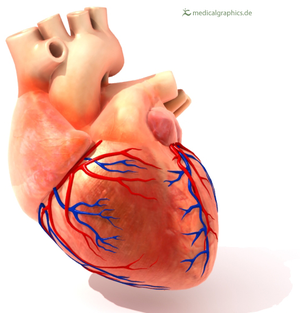
A computer generated image of a heart.
The heart is an organ which pumps blood around the body.
About the Heart
- The heart is made of muscle tissue, connective tissue, nerve tissue, and blood.
- The muscles in the heart contract and relax to pump blood.
- A healthy heart beats around 70 times per minute when you are resting.
- The heart beats faster when you exercise.
- The heart is protected by the rib cage.
- The heart has 4 separate chambers; the Right Atrium, Right Ventricle, Left Atrium and Left Ventricle.
| A diagram showing the 4 chambers of the heart. | A diagram showing the blood flow through the heart. |
- Deoxygenated blood enters the right atrium. The atria contract, pushing the blood from the right atrium into the right ventricle. The ventricles contract pushing the blood out of the right ventricle towards the lungs. Oxygenated blood returns from the lungs and enters the left atrium. The atria contract, pushing the blood from the Left atrium into the Left ventricle. The ventricles contract pushing the blood out of the Left ventricle to the rest of the body.
| A computer generated animation of the heart pumping. |
Key Stage 4
Meaning
The heart is an organ in the circulatory system which pumps blood around the body.
About the Heart
- The heart has 4 separate chambers; the Right Atrium, Right Ventricle, Left Atrium and Left Ventricle.
- Deoxygenated blood enters the right atrium from the Vena Cava. The atria contract, pushing the blood from the right atrium through the tricuspid valve into the right ventricle. The ventricles contract pushing the blood out of the right ventricle through the semilunar valve into the pulmonary artery which takes blood to the lungs. Oxygenated blood returns from the lungs through the pulmonary veins and enters the left atrium. The atria contract, pushing the blood from the Left atrium through the bicuspid valve into the Left ventricle. The ventricles contract pushing the blood out of the Left ventricle through the semilunar valve into the Aorta which takes the blood to the rest of the body.
| A diagram showing the features of the heart. |
References
Edexcel
- Heart (structure of), page 63, GCSE Combined Science; The Revision Guide, CGP, Edexcel
- Heart (structure of), page 91, GCSE Biology; The Revision Guide, CGP, Edexcel
- Heart (structure of), pages 267, 268, GCSE Biology, CGP, Edexcel
- Heart, pages 114, 116-117, GCSE Combined Science, Pearson Edexcel
- Heart, pages 166, 168-169, GCSE Biology, Pearson, Edexcel
- Heart; cardiac output, page 117, GCSE Combined Science, Pearson Edexcel
- Heart; cardiac output, page 169, GCSE Biology, Pearson, Edexcel
- Heart; valves, page 168, GCSE Biology, Pearson, Edexcel
OCR
- Heart, page 29, Gateway GCSE Combined Science; The Revision Guide, CGP, OCR
- Heart, page 36, Gateway GCSE Biology; The Revision Guide, CGP, OCR
- Heart, pages 74-77, 260-261, Gateway GCSE Biology, Oxford, OCR
- Heart; disease, pages 238-241, Gateway GCSE Biology, Oxford, OCR
- Heath; and disease, pages 208-221, 228, Gateway GCSE Biology, Oxford, OCR
- Heath; vaccinations, pages 226-227, Gateway GCSE Biology, Oxford, OCR
